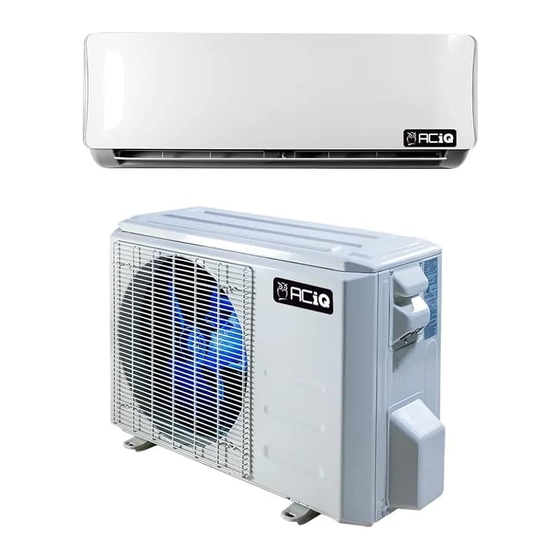
Table of Contents
Advertisement
Quick Links
SPLIT-TYPE ROOM AIR CONDITIONER
Owner's & Installation
Manual
IMPORTANT NOTE:
Read this manual carefully before installing
or operating your new air conditioning
unit. Make sure to save this manual for
future reference.
Applies to ACIQ-09Z-HP115, ACIQ-12Z-HP230,
ACIQ-18Z-HP230, ACIQ-24Z-HP230, ACIQ-30Z-
HP230, ACIQ-36Z-HP230
Advertisement
Table of Contents

Summarization of Contents
Safety Precautions
WARNINGS FOR PRODUCT USE
Essential safety guidelines for using the air conditioner, covering potential hazards and warnings.
CLEANING AND MAINTENANCE WARNINGS
Important warnings related to cleaning and maintenance procedures to prevent damage or injury.
ELECTRICAL WARNINGS
Critical safety information regarding electrical connections, power supply, and grounding.
WARNINGS FOR PRODUCT INSTALLATION
Key warnings and precautions that must be followed during the installation process.
Note about Fluorinated Gasses
Information regarding fluorinated greenhouse gasses used in the unit and related handling.
WARNING for Using R32/R290 Refrigerant
Specific safety warnings and requirements for models using R32 or R290 refrigerants.
European Disposal Guidelines
Guidelines for the correct and environmentally friendly disposal of the air conditioning unit.
Unit Specifications and Features
Indoor unit display
Details on the indicators and symbols displayed on the indoor unit's display window.
Operating temperature
Specifies the operational temperature ranges for different modes to ensure optimal performance and safety.
Other Features
Describes additional functionalities and features of the air conditioning unit.
Setting Angle of Air Flow
Instructions on how to adjust the vertical and horizontal airflow direction for user comfort.
Manual Operation (without remote)
Procedure for operating the unit manually when the remote control is unavailable.
Care and Maintenance
Cleaning Your Indoor Unit
Step-by-step guide for cleaning the indoor unit, including safety precautions.
Cleaning Your Air Filter
Instructions for cleaning the air filters to maintain unit efficiency and air quality.
Air Filter Reminders (Optional)
Information on how to reset the filter cleaning and replacement reminders.
Maintenance - Long Periods of Non-Use
Recommended procedures for maintaining the unit during extended periods of non-operation.
Maintenance - Pre-Season Inspection
Checks and maintenance steps to perform before periods of frequent use or the start of a season.
Troubleshooting
Common Issues
Lists common problems and their possible causes that do not necessarily indicate a malfunction.
Poor Cooling Performance
Diagnoses and provides solutions for inadequate cooling performance.
Unit Not Working or Starting Issues
Troubleshoots problems with the unit failing to turn on or starting/stopping erratically.
Poor Heating Performance
Identifies causes and solutions for insufficient heating output.
Indicator Lamps and Error Codes
Interprets flashing indicator lights and error codes for diagnostic purposes.
Accessories
Included System Accessories
Lists and describes essential accessories included with the air conditioning system.
Piping and Connection Parts
Details on connecting pipe assembly and related parts required for installation.
Installation Summary - Indoor Unit
Select Installation Location
Overview of choosing the optimal location for the indoor unit.
Determine Wall Hole Position
Guidance on marking and preparing the wall hole for piping.
Attach Mounting Plate
Steps for securely attaching the indoor unit's mounting plate to the wall.
Unit Parts
Indoor Unit Components
Details on key components of the indoor unit, including mounting plate, panel, filters, and cables.
Outdoor Unit Components
Information on the outdoor unit's power cable and related accessories.
Remote Control System
Details about the remote control and its holder.
Indoor Unit Installation
Prior to Installation Checks
Preparatory steps and checks before beginning the indoor unit installation.
Selecting and Preparing Installation Location
Guidelines for choosing and preparing the site for the indoor unit.
Mounting Plate Installation
Instructions for securely mounting the indoor unit's mounting plate to the wall.
Drilling Wall Hole
Procedure for drilling the wall hole for refrigerant piping and drain hose.
Refrigerant Piping and Drain Hose Preparation
Steps for preparing the refrigerant piping and connecting the drain hose.
Signal Cable Connection
Instructions for connecting the signal cable between indoor and outdoor units.
Bundling and Insulating Cables
Steps for bundling and insulating refrigerant pipes, drain hose, and signal cable.
Mounting the Indoor Unit
Final procedure for attaching the indoor unit to the mounted wall plate.
Outdoor Unit Installation
Selecting Outdoor Unit Location
Criteria for selecting an optimal installation location for the outdoor unit.
Drain Joint Installation
Procedure for installing the drain joint on the outdoor unit.
Anchoring the Outdoor Unit
Instructions for securely anchoring the outdoor unit to the ground or a wall bracket.
Refrigerant Piping Connection
Pipe Length Considerations
Information on how pipe length affects unit performance and specifications.
Piping Preparation and Cutting
General guidelines for preparing, cutting, and flaring refrigerant pipes.
Pipe Connection Procedures
Detailed steps for connecting flared pipe ends to unit ports and valves.
Air Evacuation
Evacuation Preparations and Instructions
Essential preparations and step-by-step guide for system evacuation using a vacuum pump.
Adding Refrigerant
Guidance on calculating and adding refrigerant based on pipe length and unit type.
Electrical and Gas Leak Checks
Pre-Test Run Safety Checks
Confirms electrical system safety, grounding, and proper terminal coverage before operation.
Gas Leak Detection
Verifies all pipe connection points for leaks using soap/water or a leak detector.
Electrical Leakage Test
Performs an electrical leakage test during operation to ensure safety.
Test Run
Performing the Test Run
Detailed procedure for performing the final test run to ensure proper unit operation.
Double-Checking Pipe Connections
Re-checking refrigerant pipe connections during test run to detect any new leaks.
Special Test Conditions
Procedure for testing the COOL function when ambient temperature is low.











Need help?
Do you have a question about the ACIQ-12Z-HP230 and is the answer not in the manual?
Questions and answers